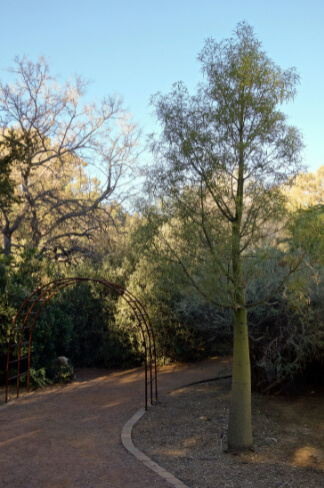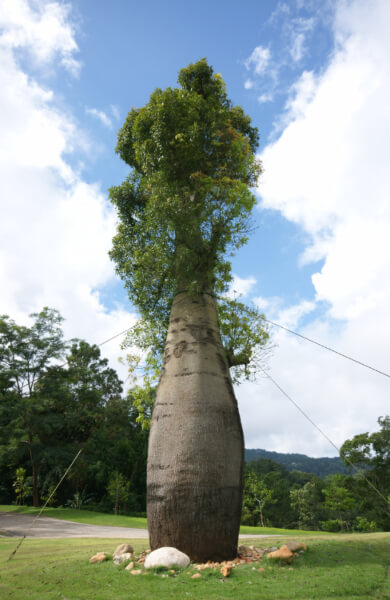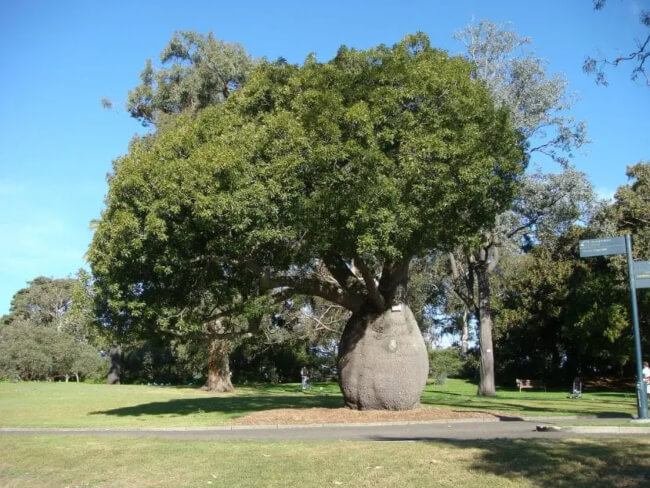I believe that the Queensland Bottle Tree is one of the most iconic and unique-looking Australian trees, widely celebrated for its large bulbous trunk that can boast a diameter of up to almost four metres when full.
An excellent tree to add interest and spectacle to larger landscapes, it features an attractive grey bark, creamy-yellow flowers with pink markings and sporadic elliptical glossy foliage.
In this article, I will explain everything you need to know to grow and care for this picturesque Australian tree in your garden.
More...

Family: | Malvaceae |
|---|---|
Genus: | Brachychiton |
Species: | B. rupestris |
Origin: | Australian Native |
Common Names: | Queensland Bottle Tree, Narrow-Leaved Bottle Tree |
Location: | Outdoor |
Type: | Large tree |
Growth: | 10 to 20 metres tall, 5 to 12 metres wide |
Sun requirements: | Full sun |
Foliage Colour: | Green |
Flower Colour: | Creamy-yellow with pink markings |
Flowering: | Spring to summer |
Edible Parts: | None |
Maintenance level: | Low |
Poisonous for pets: | Plant material can cause gastrointestinal irritation if consumed |
Introducing Queensland Bottle Tree
Apart from its distinctive bottle-shaped trunk, the Queensland bottle tree also sports a spreading and dense growth habit, perfect for many ornamental applications within outdoor spaces.
Enjoy showy silhouettes and get your neighbourhood talking with this spectacular Australian native.
Brachychiton rupestris Plant Details
Botanically labelled Brachychiton rupestris, the tree is commonly known as the Queensland bottle tree or the narrow-leaved bottle tree. Part of the Malvaceae family, it is native to Queensland where it is considered a vital succulent tree in its habitats.
Tolerant to a wide range of temperatures, the tree will certainly perform its best in warmer climates like warm temperate, subtropical, tropical and Mediterranean regions. It is a deciduous species and will lose its leaves during droughts and before flowering.
Considered slow-growing until mature, the tree can reach up to 20 metres tall and 12 metres wide in its natural environment but cultivated in large gardens and properties, it will typically only reach between 6 to 12 metres tall and 6 to 9 metres wide.
It's good to know that it will only sport its unique bottle-shaped trunk after 5 to 8 years. The trunk eventually acts as water storage for the tree. The Queensland bottle tree will work perfectly as a wow factor feature tree but it can also be used as wind protection or as a shade tree.
How to Grow Queensland Bottle Trees

This is a hardy, adaptable and long-lived species that adapts readily to cultivation. The most common and easiest way to grow a bottle tree is to use seeds.
However, seed-grown trees can take up to 20 years to flower. Seeds are also covered in irritating hairs within the pods so be sure to take care and use good gardening gloves when handling seeds. Seeds purchased online or in-store should not have hairs around them.
Alternatively, many reputable nurseries will stock younger specimens that can easily be transplanted into your garden, giving you a fantastic head start which will mean you will have a mature and flowering tree sooner.
This species does respond very well to transplanting so this is a good option, especially for beginners. Lastly, these trees can also be propagated using semi-mature growth taken in late summer.
Growing QLD Bottle Tree from Seeds
- Prepare well-drained containers for your seeds and fill them with a moist potting medium mixed with a quality seed-raising mix.
- Sow seeds about 1.5 cm deep and mist lightly after sowing.
- Place the containers somewhere warm and sheltered and keep the soil slightly moist at all times.
- Viable seeds will germinate in a couple of weeks.
- Allow seedlings to develop to a good size for handling then pot them up into larger containers as needed as they grow.
- Plant seedlings out into the garden in early spring once the soil is warmer.
Propagating Narrow-Leaved Bottle Tree using Cuttings
- Take semi-mature cuttings from small branches of a mature tree in late summer using sharp and sterilised pruning shears or a pruning saw.
- Cuttings should be at least 12-15 cm in length.
- Trim the ends of your cuttings at a 45-degree angle and remove most of the leaves and extra branches.
- Prepare well-drained containers by filling them with a quality potting mix with some perlite. You can also mix in a seed-starting mix.
- Lightly water the soil and dip the cut end of the cuttings into a rooting hormone.
- Make a planting hole in the potting medium and add the cutting, firming the soil around it once in place. Lightly firm soil to eliminate air pockets.
- Water in once planted and keep the soil slightly moist.
- Place your cuttings in a warm spot that gets good amounts of indirect light.
- Cuttings should root in about 90 days.
Ideal Growing Conditions for Queensland Bottle Tree

When choosing your planting site, it is important to keep in mind that this tree will grow to be a large specimen, able to reach 15 metres tall and 9 metres wide. It is recommended to leave at least 9 metres of space between your bottle tree and other trees and buildings.
Overall, it is an adaptable species that can tolerate a range of growing conditions however, certain conditions will ensure your tree thrives and looks its best.
Planting should be done in early spring to midsummer once the weather and soil are warmer.
Ideal Soil
The tree can tolerate a wide range of soil types but it does tend to grow best in well-drained, slightly acidic soil. It prefers sandy or loam-based soils but can also tolerate clay. An ideal soil pH level is between 6.1 to 6.5 so be sure to check your soil with a soil tester before planting.
Sunlight Needs
Being a Queensland native, this tree grows best in full sun. Pick a sunny spot in your garden that allows for adequate growing space. The tree should also not be shaded over by other trees or buildings, especially during development.
Ideal Temperature Conditions
The narrow-leaved bottle tree does best in hot, relatively dry climates where winter temperatures mostly remain above -5°C.
Quick Planting Tips
- The planting hole should be slightly wider but to a similar depth to the tree's pot or root ball.
- The depth of the soil should match the existing soil mark on the trunk.
- Firm the soil around the tree’s roots after planting and use your feet to lightly tamp the top layer of soil down.
- If you have poor soil, you can dig in some compost or well-rotted manure before planting then side-dress with compost annually.
- Water well after planting.
Queensland Bottle Tree Care Guide
Once fully established after about 5 years, the tree will tolerate high temperatures and drought well. It will lose some of its trunk’s girth during periods of drought as it feeds on its stored water supplies.
This species can withstand only light frosts down to about -6 to -8°C. Overall, caring for this tree should be low-maintenance as it is quite self-sustainable.
Watering Schedule
Because this plant stores so much water in its trunk, it only requires little supplemental water once established. While young, water well. On average, water deeply once every 3 weeks or so depending on how dry and hot it is.
Fertilising Brachychiton rupestris
Feed once per year in spring with a balanced 10-10-10 garden fertiliser.
Pruning Needs
Pruning may not be needed at all, especially in larger landscapes. You can prune to keep the tree at a certain size or shape for smaller spaces. Prune in winter to remove spent flower heads and remove only one-third of the desired branches.
Mulching
In hot and dry summers, add an 8 to 10-centimetre layer of organic mulch around the base of the tree to help it conserve more water.
Helpful Guide: Best Types of Mulch for the Garden – When and How to Use It
Transplanting Tips
Mature trees transplant readily and can survive a couple of months out of the ground. Always transplant in early spring to late summer when the weather and soil are warmer as this will encourage good root development. Transplant into well-drained soil in a spot that gets partial shade.
QLD Bottle Tree Pests, Problems and Diseases
There are no serious pest or disease issues that affect this hardy species. Yellowing leaves should indicate that your soil may be too alkaline-heavy. Test and adjust it as necessary. You can add some elemental sulphur to help correct the pH level.
Queensland Bottle Tree Freqently Asked Questions
How long does a Queensland bottle tree take to grow?
The tree will only develop its unique bottle-shaped trunk after about 5 to 8 years depending on the growing conditions. This is when it is considered fully established.
How long does a Queensland bottle tree live?
These hardy natives can live for up to 3,000 years in their natural habitat. You can be sure that you will be able to enjoy this tree for generations on the property.
What is the difference between a boab tree and a bottle tree?
The Australian baobab tree is related to the Madagascan and African baobabs whereas the QLD bottle tree has no relation and is a unique species of its own.
Where does the QLD bottle tree occur?
This species is endemic to a very limited region of Australia, namely Central Queensland to northern New South Wales.
Are Australian bottle trees messy?
These trees can cause some mess in gardens. Because their seed pods decay slowly, it can lead to a lot of messy seed pods being scattered on the ground around the trees. A good cleanup after flowering can help.
What are the benefits of the QLD bottle tree?
This picturesque tree is perfect for providing gardens with shade for lower-growing vegetation as well as shelter and food for local fauna, big and small. The tree suits larger landscapes well where it is commonly used as a “wow factor” feature specimen.
What is the significance of the bottle tree?
Folk legend states that bottle trees can ward off evil spirits on properties.
When does the QLD bottle tree flower?
The tree will adorn itself with beautiful bell-shaped creamy-yellow flowers from October to December. The clusters of blooms add lovely pops of colour to the ends of the tree branches, further elevating the tree’s aesthetic appeal.
For more plants native to Queensland, check out our list of growing guides below:
Enjoy One of Australia’s Most Picturesque Natives with the Queensland Bottle Tree
A true Australian stunner, the Queensland bottle tree is the perfect pick for anyone with a large garden looking to add spectacle and a unique quirkiness to their outdoor spaces.
Whether for its celebrated bulbous trunk or its gorgeous canopied silhouettes, this tree is a must-have for those who have the space. Enjoy one of our most beloved native trees and start growing your Queensland bottle tree today.
Published on July 25, 2023 by Lorri Hopkins
Last Updated on February 24, 2024






I have a fine leaf bottle tree with sap coming out of trunk it has just lost its leaves another 6 m away is normal
.also a wide leaf one that lost its leaves a month ago now with dry ends another 12 m away normal .
Can you give me any suggestions.
Flame tree is fully growing nearby.
I have a wide leaf bottle that lost its leaves over a month ago . Tips are dry . Another wide leaf 15 m away is fine . Also a fine leaf bottle has just lost its leaves with sap oozing from trunk. Another fine leaf 20m away is fine.
But my flame tree is powering in growth it’s nearby . Any suggestions please
Hi Alison,
They shouldn’t be dropping leaves at this time of year, but if there’s been any cold winds near you of late, that can contribute to natural but premature leaf drop. The fact the leaves are just brown at the tip seems like either heat scorch (something caused by cold as well – basically just the leaf drying up to protect itself).
Because it’s spread to a few in different parts of the garden though, it could be pest related, but the fact it’s just the leaf tip makes it sound too located to be something like spider mites or thrips.
Have you got any pictures and I’ll see if I can shed some more light on this for you.
Best regards,
Lorri Hopkins